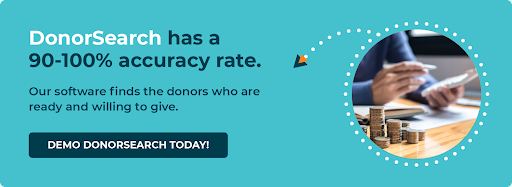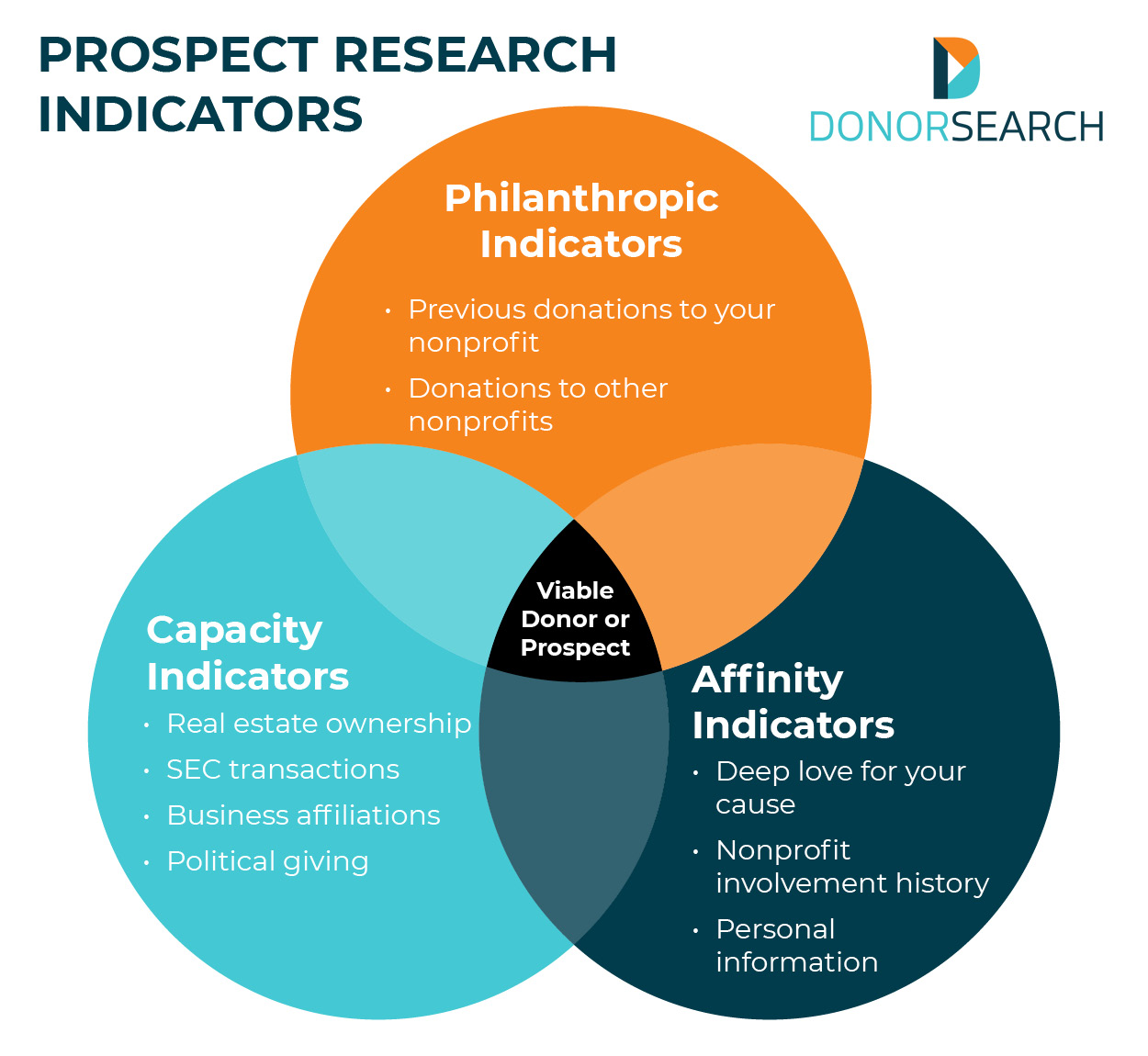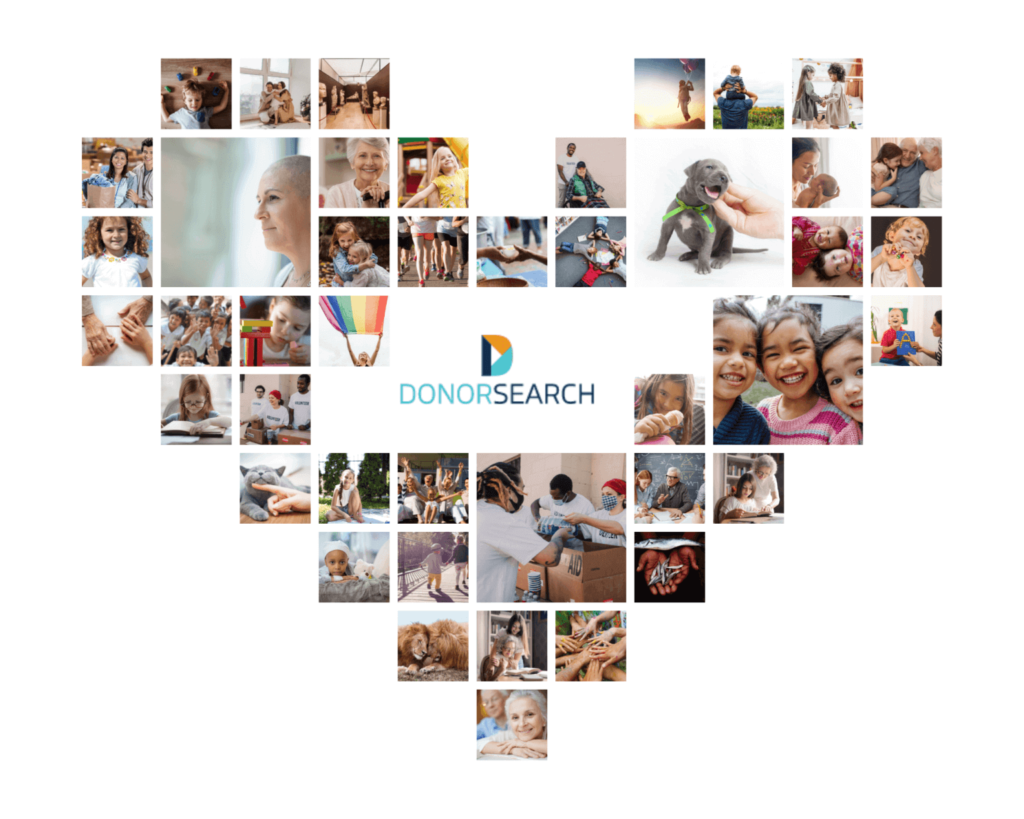It’s critical for nonprofits to have healthy and effective fundraising strategies that empower them to maintain relationships with current and new donors who drive their missions forward. One of the most effective ways to strengthen your fundraising efforts toward these ends is to conduct thorough prospect research…
Whether your nonprofit is looking to strengthen its existing major giving program, solicit major gifts as part of capital campaign planning, or even kickstart its very first development initiatives, prospect research will be integral.
However, you may be new to the process or need some refreshment. That’s where this crash course comes in. In it, we’ll give you a comprehensive overview of prospect research and the steps you need to take to get started.

Screen prospects quickly to get the freshest insights possible. Explore the tools DonorSearch has to help you get ahead!
Frequently Asked Questions About Prospect Research
Prospect research can be a daunting undertaking, especially for smaller or newer organizations. In this section, we’ll cover some of the frequently asked questions nonprofits often have when jumping into donor prospecting.
What is prospect research?
Prospect research, also called donor prospecting, screening, or donor research, is a technique used by nonprofit fundraisers, major gift officers, and development teams to identify high-impact donors within and beyond an organization’s current donor pool. Through this process, nonprofits gather an immense amount of data—information about donors’ backgrounds, past giving histories, wealth indicators, philanthropic motivations, and more.
How does prospect research differ from wealth screening?
When learning about prospect research, you may come across the term “wealth screening.”
Traditional wealth screening falls under the “prospect research” umbrella. Typically, wealth screening focuses on analyzing donors’ and prospects’ wealth markers such as real estate ownership, business affiliations, and stock holdings. These help your organization determine a donor’s financial giving capacity.
However, just because a donor has the capacity or wealth to donate to your organization doesn’t necessarily mean they have the willingness or affinity to do so. Wealth screening that takes into account a donor’s philanthropy and affinity provides a fuller picture of potential donors than honing in on wealth details alone.
What types of nonprofits use prospect research?
Prospect research is used by various organizations to improve their fundraising efforts. Here are a few examples of organizations that conduct prospecting and how each utilizes the data they collect:
- K-12 Schools: Parents and families of students should be screened during the research process, especially at the beginning and end of the school year and around graduation, to see how much they could contribute to the school’s annual fund and other giving campaigns.
- Colleges, Universities, and Sororities and Fraternities: Donor research provides a way to segment large pools of alumni into different potential giving groups, resulting in more targeted and successful solicitation efforts.
- Healthcare Organizations: Early and frequent research can help grow grateful patient donor programs.
- Advocacy and Social Service Organizations: Large volunteer pools and event attendee lists mean there are always new prospects to screen and analyze for future giving potential.
- Arts and Culture Organizations: Screening single-ticket purchasers, special event attendees, membership holders, and consistent donors can lead to more support.
- Environmental Groups: With a calendar full of events and volunteer activities, these organizations should be screening attendees for more targeted donor cultivation.
- Faith-Based Organizations: Churches, mosques, synagogues, and other places of worship can pinpoint parishioners or frequent service attendees who are likely to contribute major gifts.
What are the benefits of prospect research?
Prospect research can enrich your nonprofit’s operations in a myriad of ways. When you prospect, you will be able to:
- Screen current donors: A major donor may be hiding in your current pool of donors. Prospect screening can reveal who in your donor base has the capacity to make a major gift.
- Generate new prospects: Donor research allows you to expand your nonprofit’s reach and find new potential donors. You’ll grow your community and your revenue generation capabilities!
- Refine your major gift strategy: Whether you’re seeking major gifts for a capital campaign or looking to strengthen your planned giving program, prospecting saves you time and money by helping you focus your efforts on prospects who are likely to give.
- Optimize ongoing fundraising activities: With a wealth of data at your fingertips, your organization can see trends in its fundraising efforts and refine its goals and strategies for the future.
- Identify corporate giving opportunities: Find out if your donors are eligible for corporate giving programs like matching gifts or volunteer grants as you gather information about donors’ giving histories, employers, and more.
- Fill gaps in donor data: Donors may move, get married, or change their phone numbers. Prospect research can help you fill gaps in inaccurate or out-of-date information.

Screen prospects quickly to get the freshest insights possible. Explore the tools DonorSearch has to help you get ahead!
The Elements of Prospect Research
To successfully conduct prospect research for your nonprofit using prospect research tools, you’ll need a solid understanding of its key elements—the tools you’ll be using and the indicators you’ll be looking for in the data you gather. Let’s explore both of these elements!
Prospect Research Tools You’ll Need
-
Prospect research database
A comprehensive database such as DonorSearch will inform your organization about prospects’ charitable giving, business connections, real estate ownership, stock holdings, corporate giving opportunities, and more.
-
Your nonprofit's CRM
The internal data you already have in your CRM can provide important information about your organization’s fundraising trends. This can be a starting point for learning more about current donors and their connections to new prospects, as well as identifying potential major donors within your existing supporter base.
-
SEC investment records and FEC political contribution records
These government records can supplement your prospect research data to show you which prospects or donors have the capacity and propensity to give a large gift.
-
Prospect generator solutions
A prospect-generating tool like DonorSearch’s ProspectView Online 2 (PVO2) can provide you with lists of prospects who have given to causes similar to yours. Plus, PVO2 summarizes data through customizable AI-powered prospect reports so you can understand potential donors at a glance.
-
Predictive modeling solution
These AI tools organize your prospect lists and make suggestions about which donors to reach out to first so you can improve results while saving time and resources. Our machine learning tools, DonorSearch Ai and DonorSearch Enhanced CORE, score prospects based on probabilities including response to appeals, acquisition, retention, conversion to sustainer status, upgrade, and lifetime value.
-
Generative AI communication tool
Once you’ve determined which prospects are your top priority for outreach, generative AI can help streamline content creation. In particular, DonorSearch Ai + Momentum uses predictive modeling insights to inform content generation and ensures outputs match your gift officers’ writing voice and tone.
-
Matching gifts database
A matching gifts database is important for finding out which donors and prospects can request donation matches from their employers. This provides insights into their professional connections and shows where opportunities exist to increase contributions without asking more of donors themselves.
In addition to these tools, simple internet searches and deep dives into prospects’ social media profiles can help reveal who your donors are and what they value. Discover how our wealth and philanthropic screening tools, PVO2, DonorSearch Ai, and our partnership with Momentum can help your nonprofit learn about potential donors in detail!

Prospect Research Indicators to Know
During the prospect research process, you’ll be looking for three kinds of indicators: philanthropic indicators, affinity (warmth) indicators, and wealth (capacity) indicators. Note that these indicators can also be referred to as “markers.” Let’s dig into each of these indicators in detail.

Philanthropic Indicators
These indicators show that a donor or prospect may be willing to give a donation to your organization because they have philanthropic tendencies. Here are a few examples of philanthropic indicators:
-
previous donations to your nonprofit
As past giving has always been one of the greatest indicators of a prospect’s willingness to donate in the future, previous donations to your nonprofit should be included as a part of a thorough prospect profile.
-
donations to other nonprofits
If a donor has given to other nonprofits in the past, it’s a solid indication of charitable habits, especially if these nonprofits have missions similar to or related to your own. Prospect research profiles should incorporate information based on other nonprofits’ annual reports and recognition documents.
Affinity Indicators
These indicators show that a donor or prospect may be willing to give to your organization because they love your specific work. Here are a few examples of affinity indicators:
-
deep love for your cause
Whether they love your nonprofit’s mission because they are a grateful recipient of your services or simply because they’re passionate about your vision for a brighter future, having a deep connection with your cause lets you know that a donor or prospect may be ready to say “Yes!” to a donation ask.
-
nonprofit involvement history
Nonprofit involvement indicates that a prospect values and understands the general importance of philanthropy. Foundation trustees, board members, volunteers, and advocates are likely future donors.
-
personal information
Beyond basic information, personal information about hobbies, interests, and values can be gleaned from public social media profiles or internet searches. This information is useful in determining prime prospects based on their personal philanthropic interests.
Capacity Indicators
These indicators help you to know whether or not a donor or prospect is in a financial position to give a large gift, and can assist you when determining how much to ask for down the line. Here are a few examples of wealth indicators:
-
real estate ownership
Real estate ownership helps determine wealth. Plus, individuals who own real estate valued at $2+ million are 17 times more likely to give philanthropically than the average person.
-
SEC transactions
Stock holdings at publicly-traded companies are reported to the SEC and available through SEC.gov. They provide a clear window into a donor’s finances.
-
business affiliations
With these indicators, you can learn about a donor’s career, and, by extension, estimated financial situation.
-
political giving
Someone who has donated large sums of money to political campaigns has the financial capacity to make a major gift. Plus, you may find that a prospect’s political leanings give them a greater affinity for your mission.
Additionally, depending on where your prospects work, they might be able to boost their impact via corporate social responsibility programs such as matching gifts. In fact, a stunning $2-3 billion is donated each year in matching gift revenue. Collecting employer information helps you determine which prospects are eligible for matching gifts so you can tailor your marketing efforts and raise more.
Remember, in thorough prospect research, you can’t have one type of indicator without the other. Wealth indicators and philanthropic indicators are both crucial to finding the most viable prospects for your nonprofit.
Exploring Your Options: 3 Approaches to Prospect Research
You have a few different options when it comes to how you conduct prospect research. Let’s look at each approach and why an organization might choose it.
1. Conducting In-House Prospect Research
There are two ways to go about in-house prospect research.
The first is do-it-yourself (DIY) prospect research. This approach involves having an existing staff member take responsibility for prospecting. If your nonprofit is just starting out or if you have a tight budget, this may be a great initial option. Although it won’t be a sustainable long-term solution as your organization grows, it’s an accessible way to begin prospect research so you can kickstart that growth.
DIY prospect research usually involves a member of your development team sitting down with a list of your very top prospects and performing online research with prospect research tools. If you’re interested in more in-depth training, there are plenty of great resources from classes to webinars that are available through popular prospect research channels.
The other way to conduct prospecting in-house is to hand the job over to full-time research staff. Usually, organizations bring on research teams if they have a large prospect pool and need to free up other staff members’ time, so if you’re a midsize or large organization with the means to outsource this work, this may be a good choice.
Full-time research is a challenging job that requires a combination of both extensive fundraising experience and a naturally inquisitive and investigative nature. Researchers use tools to take masses of raw data and turn it into usable, digestible information. As such, look for candidates who have analytical minds, understand the minutiae of databases, and know how to synthesize data.
2. Working with a Prospect Research Consultant
Another option for conducting prospect research is to hire a prospect research consultant. Consultants are experts in prospecting. They know how to use prospect research tools and interpret the philanthropy, affinity, and capacity markers they see in the data. They can also help you put your data into action and begin cultivating relationships with prospects.
Here are a few questions to ask yourself if you’re interested in working with a prospect research consultant:
- What are you looking to gain? Determine what kind of research you need conducted—do you want to screen your current donors? Looking for new prospects? Once you know what research you need done and how that will help your nonprofit accomplish its goals, you’ll be able to go into the consultant hiring process fully aware of your organization’s needs and ready to look for the right partner to fulfill those needs.
- What kind of access do you need to your consultant? Consider whether you need a consultant that will be available full-time or part-time. Also consider if you’re willing to work with a consultant remotely or if you’d like to work with someone in your local area.
- Do they have samples of their work? Review samples or case studies of the types of donor profiles your potential consultants can put together. Not only will this preview of their work give you a sense of the options you’ll have should you choose to work with that consultant, but it will also provide an example of the quality of their work. In addition, be sure to reach out to the consultants’ references.
3. Partnering With a Prospect Screening Company
A prospect screening company can be a valuable partner, especially if you’re actively seeking out major gift donors from your current donor pool. These experts can help you know who among your donors would be an ideal major giving candidate and how much you can reasonably ask for when you solicit a donation.
If you have a large number of records in your donor database, then a bulk screening could potentially help you sort through the masses of information. Bulk screenings sift out only the most pertinent and useful donor data and serve it in a neat package that your organization can easily analyze.
A screening company can help your organization as it grows, too. If you’re acquiring new members or donors regularly, screening services can help you keep track of, sort, and assess all the new prospects in your donor pool.
Additionally, a good screening company will be able to seamlessly integrate its tools with your existing software and align with your normal workflow, meaning that your data will always be easy to get to when you need to access it. Many screening companies offer comprehensive integration support to make the data transition as smooth as possible.

The 7-Step Process of Donor Research
Now that you know the what, how, and who of prospect research, it’s time to dial into the specifics. Let’s jump into the seven-step process of donor research.
-

1. Create a plan of action.
Once the data is in your hands, it’ll be tempting to dive into the results first and ask questions later. To ensure that your team is taking the most responsible and reasonable approach possible, it’s best to plan out exactly how you’ll be handling the analysis process before conducting research.
-

2. Clean up your data.
Remember that your organization’s CRM will be a valuable tool during the prospecting process. So, cleaning up your data before conducting fundraising research is essential to receive the most accurate and helpful results efficiently. Usually, this will involve consolidating duplicate profiles, updating outdated contact information, and removing lapsed donors from your records.
How extensively you clean up your data depends on the state of your existing information. Your data doesn’t need to be perfect—it just needs to provide enough information to reap usable results.
-

3. Validate your results.
Once your results are in, you’ll want to validate them to ensure they’re accurate and make the most logical sense. For instance, if a donor has a common name like “Tim Smith,” the researcher might have pulled data for someone who shares that name. Or, you might not have the most up-to-date contact information for a prospect.
Take the time when your results first come in to ensure their accuracy. This way, you’ll spend less time on the other end accounting for misinformation.
-

4. Analyze your results.
Your screening results will provide a wealth of useful information. The best step you can take once you have this data at your fingertips is to analyze it thoroughly.
Start by organizing portfolios for each of your prospects. Through this process, you’ll establish qualification criteria for different giving levels, helping you determine the prospects you should reach out to first.
-

5. Make a solicitation plan.
Creating a solicitation plan can help you structure the process and standardize it for future fundraising efforts. Start by setting goals for how much you want to raise and how many donors you plan to solicit gifts from.
Then, group your donors based on shared characteristics. Decide what segmentation criteria you’ll use to tailor solicitation messages, such as preferred communication method, giving capacity, and interests.
Finally, develop solicitation strategies–the more personal, the better! For instance, instead of a generic email follow-up, send an eCard addressed to the prospect, tailored to their interests, and featuring their personal information.
-

6. Solicit donors.
After prospecting, you should have a better sense of how much you should ask for, your donor’s preferred communication channels, and their giving motivations and connection to your mission.
You’ve spent considerable time building out your donor profiles, so you should definitely use them! Especially as you cultivate major donors based off of a gift range chart, keep track of your efforts in your database so that your team can make adjustments.
-

7. Make improvements to your prospect research process.
No process is streamlined during the first pass, and that’s perfectly okay! After you’ve gone through all the steps of researching, cultivating, and soliciting, it’s time to take a step back and assess.
As with anything else in the nonprofit world, becoming a prospect research expert might involve a steep learning curve. But in the end, the efforts you expend to refine your technique will be well worth it as you can find more prospects and grow your organization!
Final Thoughts
Prospect research helps you find the people with the means and the passion necessary to contribute generously to your cause. While the process may seem daunting and complex at first, as you leverage the right tools, know what to look for, and secure the right support for your team, you’ll be successful in finding more donors for your mission!
But don’t just take our word for it—learn how one of our amazing clients, Didi Hirsch Mental Health Services, leveraged DonorSearch to take its prospecting and fundraising efforts to the next level, tripling its fundraising over the past year.
Did you enjoy learning about prospect research? Then we recommend these other resources:
- How to Create a Donor Profile: Ultimate Guide + Template. Detailed donor profiles can inform the major donor cultivation and solicitation processes. Dive deeper in this guide.
- Legacy Gifts: Taking Your Org’s Strategy to New Heights. Legacy gifts, also known as planned gifts, can have a big impact on your mission and empower your donors to leave their mark on the world. Discover everything you need to know in this article.
- How to Create a Standout Nonprofit Annual Report + Template. Your nonprofit’s annual report can help you expand your community and showcase your accomplishments. Learn more in this guide!

Prospect research empowers your nonprofit to connect with the right donors. By providing up-to-date insights that allow you to take advantage of every opportunity, DonorSearch can take your strategy to new heights!
